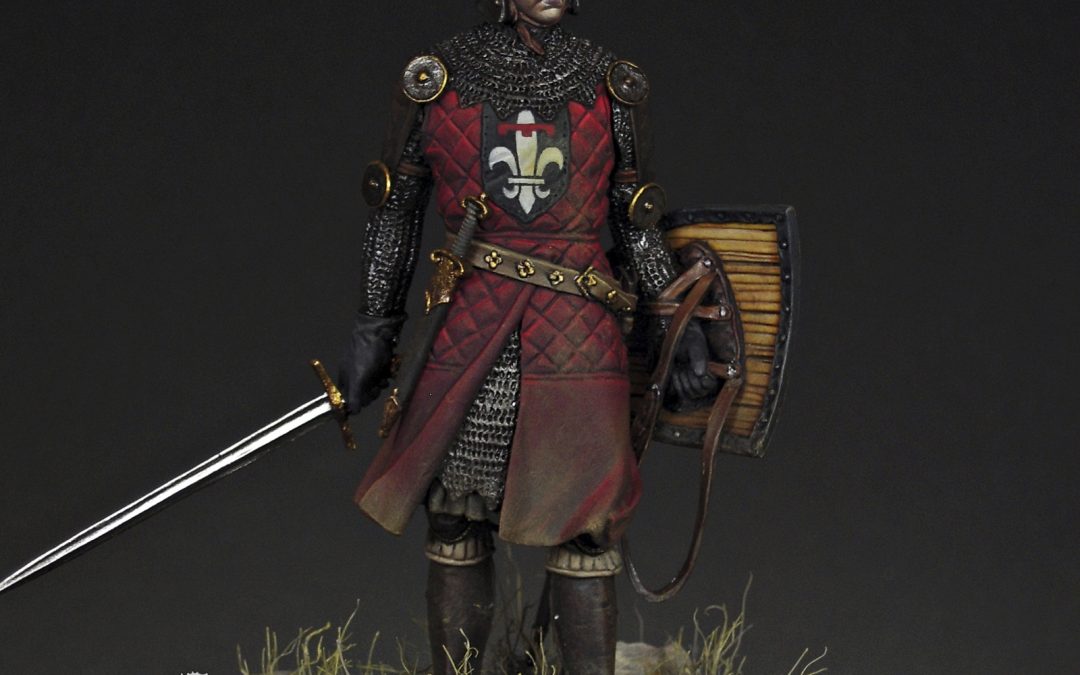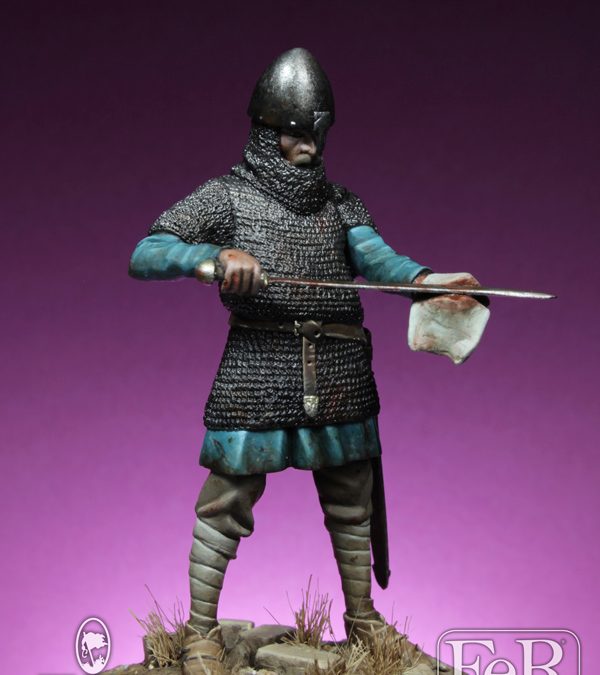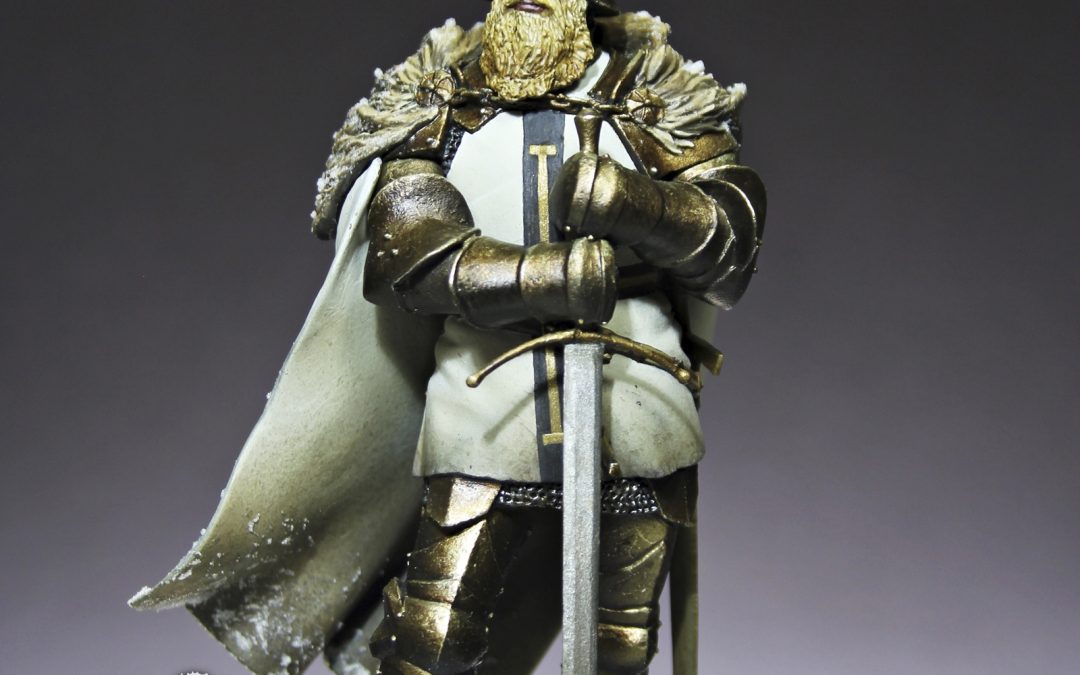
Oct 3, 2014
The initial push of the Crusades devastated the Holy Land, expelled the Muslim powers, and created diverse Christian kingdoms in the Middle East. The situation in those kingdoms was barely stable and they needed a continuous flow of warriors from Europe to guarantee their survival in front of the Arab armies’ pressure that were fighting to conquer back those territories.
At first, faith had been the main incentive for these warriors, fervent devotes that didn’t hesitate to travel across half-world to fight for their beliefs. But later, a lot of members excluded from the European societies went there for the promise of a future that offered incredible opportunities to those who dared to grab them.
Our knight could be one of those persons, either one who fought for noble principles or moved for more material desires. His garment is typical from the early XIV century. It shows the transition from protections based primarily on chainmail (omnipresent on the battlefield for several hundred years) towards a combination of chainmail, hardened leather, metallic plates, or even gambesons with multiple layers of cloth. Helmets were already evolving to much more sophisticated models than the earlier ones. Heraldry was entering its golden age and surcoats and shields were the perfect places to display it. A miniature that offers countless options of decoration for any painter.
Note: This is a resin miniature kit that requires assembly and painting.

Aug 2, 2024
The Order of the Knights of St. John, more commonly known as the Knights Hospitallers, traces its origin to the old Amalfitan hospital in Jerusalem. From their humble origins, they evolved to become one of the most important Christian military orders.
After militarising the order in the first half of the XII century, they became very active elements for the Christian kingdoms during the Crusades until the siege of Acre in 1291. After the Muslim conquest of the Holy Land, they moved their base of operations, first to Cyprus, then to the Isle of Rhodes, which they ruled until they further relocated again to Malta.
Our miniature depicts one of these monk-warriors at the end of the XIII century and can be painted as a member of any other militant order or as a generic Knight of Outremer.
Note: This is a resin miniature kit that requires assembly and painting.

May 4, 2021
The Order of Brothers of the German House of Saint Mary in Jerusalem was founded in Holy Land during the XII century with the mission of helping pilgrims visit Outremer and establishing hospitals.
Since the beginning, the order’s interests and expansion plans were more aimed at Northeastern Europe than at Holy Land. One of the earliest and more famous Grandmasters, Hermann von Salza launched a crusade against the Prussians already in 1230. Since then, their involvement in the Baltic area grew continuously.
In the early XV century, the order started to see a decline as a power in the area. With the Christianization of Lithuania, its main purpose in Europe disappeared, and also, in 1410, its defeat in the Battle of Tannenberg at the hands of a Polish and Lithuanian army was a severe blow to its aspirations. In spite of it, as they had grown as a feudal and commercial power, they still kept a mighty presence until the next century.
Our figure depicts a Teutonic Knight of the era of the Prussian Crusade, with the heraldry of the Grandmaster Conrad of Thuringia. Obviously, the figure can be painted to suit any other militant order or knight scheme from the same period. It includes an optional great helm that can be placed as an alternative head or as a decoration in the base.
Note: This is a resin miniature kit that requires assembly and painting.

Mar 26, 2021
WHY YOU SHOULD CONSIDER BUYING THIS FIGURE:
– This is a new chance to get an iconic and long-out-of-production piece by Elite Miniaturas.
– This classic Mike Blank sculpt perfectly represents the style of the Swedish artist and can be painted in many different ways!
– Our signature resin quality allows you to get the figure clean and ready in almost no time, so you may invest your precious free time in what really matters: painting and having fun.
When Pope Urban II called his fellow faithful Christians to take the road to an armed pilgrimage to Jerusalem during the Council of Clermont, in 1095, he surely wasn’t aware of the reach and historical consequences of his request. The First Crusade was, as its name indicates, the first of a series of conflicts that ravaged the Middle East for three centuries and shaped history in ways that we can even feel today.
Byzantine Emperor Alexis I Komnenos requested the help of the western Christian kingdoms for his fight against the Turkish Seljuks. When the Pope supported the request, it was met with popular enthusiasm and began the first part of the crusade, known as the People’s Crusade. With scarce organization or planning, and led by a French priest, Peter the Hermit, they traveled to the East and were annihilated once they reached Anatolia in 1096.
In the meantime, a noblemen-led strong contingent of armies started to mobilize. Among their commanders, were men like Bohemund and Tancred of Tarento, and Robert II of Normandy, ambitious Norman leaders that saw the military expedition as a way to gain fame and fortune for themselves.
The campaign was a success that culminated in the conquest of the Holy City of Jerusalem, where Godfrey of Bouillion was established as a leader. Many of the soldiers that participated in the pilgrimage decided to stay in the newly conquered lands. The whole adventure in the lands of Outremer had just started.
Our miniature could have been one of those adventurers and soldiers that traveled East in one of the contingents of the Norman lords, maybe from the original lands in Northern France or from the Tarento kingdom in the South of Italy.
Note: This is a resin miniature kit that requires assembly and painting.

Apr 17, 2017
The Order of Brothers of the German House of Saint Mary in Jerusalem was founded in Holy Land during the XII century with the mission of helping pilgrims visit Outremer and establishing hospitals.
Since the beginning, the order’s interests and expansion plans were more aimed at Northeastern Europe than at Holy Land. One of the earliest and more famous Grandmasters, Hermann von Salza launched a crusade against the Prussians already in 1230. Since then, their involvement in the Baltic area grew continuously.
In the early XV century, the order started to see a decline as a power in the area. With the Christianization of Lithuania, its main purpose in Europe disappeared, and also, in 1410, its defeat in the Battle of Tannenberg at the hands of a Polish and Lithuanian army was a severe blow to its aspirations. In spite of it, as they had grown as a feudal and commercial power, they still kept a mighty presence until the next century.
Our figure depicts a Teutonic knight in the last era of splendor for the order. He wears a state-of-the-art harness that has nothing to envy to the ones used in Western Europe. The figure can be painted to depict a wide array of subjects from the period.
Note: This is a resin miniature kit that requires assembly and painting.





